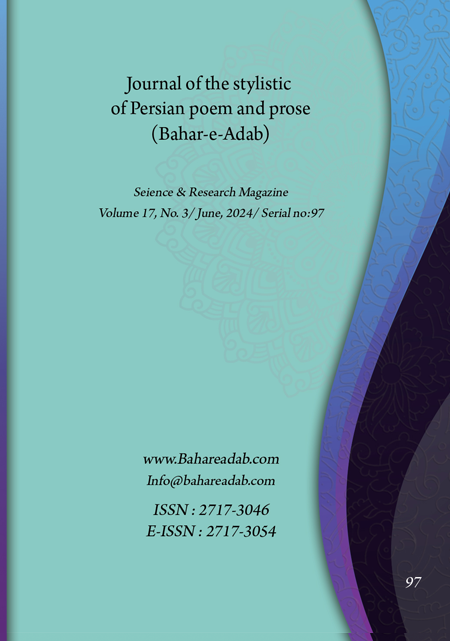- Count View : 152
- آدرس کوتاه شده مقاله: https://bahareadab.com/article_id/1643
- کد doi مقاله: Doi: 10.22034/bahareadab.2024 .17 .7201
Journal of the stylistic of Persian poem and prose
volume Number 17،
number In Volume 3،
،
issue Number 97
Investigation and analysis of the motifs of excused love in the stories "Shirin and Farhad" and "Laili and Majnoon" by Nizami
Fatemeh Sayyadi , Mahmoud Sadeghzadeh (Author in Charge), Azizollah Tavakolli
Abstract
BACKGROUND AND OBJECTIVES: This research investigates the themes and motifs of Ezri"s love in the story of Shirin, Farhad, Laili, and Majnoon. Its main issue is the answer to the question that the concepts and characteristics of excused love are similar in these two stories. In this way, they deserve to be reviewed and analyzed with each other.
METHODOLOGY: In this essay, the writer aims to show the important components and characteristics of love for excuses by describing and analyzing these two love stories, and for this purpose he has used the descriptive-analytical method.
FINDINGS: The results of the research show that Nizami was well familiar with the themes and motifs of Excuse Love and used its features to organize these two stories.
CONCLUSION: Based on this, the most important common romantic themes between the two stories are based on the characteristics of love for an excuse: the height of love in childhood and youth, scandal, attempts to connect, obstacles to connecting and inhibiting factors, travel and travel incidents, the lover"s reaction, The meeting of the lover and the beloved, the death of the lovers and the belief in connection in the other world is the end of the story and the construction of a dome for the lover and the beloved.
Keyword
Shirin and Farhad
, Laili and Majnoon
, Nezami Ganjavi
, Eshq Ezri
, romantic roles
- Alandi, R.(1999). Eshq, translated by Jalal Sattari.2 nd ed, Tehran: Tus .
- Alberoni, K.(1997) Birth of love. translated by Nagin Shahnai: Tehran: Sokhan.
- Anuari, H.(2012). Farhang Bozorg Sokhan (5th volume). 2nd ed, Tehran: Sokhan.
- Bertels, Y. A(1974) Nizami. the great poet of Azerbaijan. translated by Hossein Mohammadzadeh Sediq, Tehran: Bina.
- Esfahani. A. FAl-Aghani. (1989). Translation. summary and description by Mohammad Hossein Mashaikh Faridni, Volume 1. Tehran, Scientific and Cultural Publications.
- Ibn Dawud Isfahani, A.M;(1406) .Al-Zahrah, Haqqah and Kadam Leh and Alaq against Ibrahim al-Samrai, Jordan: Maktaba al-Manar.
- June,B.A Darse Eshgh, translated by Torandekht Tamadon .Tehran: Alborz, 1996.
- Majamal al-Tavarikh and al-Qasas, edited by Malik al-Shaara Bahar, by Mohammad Ramezani, Tehran: Khavar Printing House, 1939.
- Moin .M.(2007). Moin's Farhang (Volume 2), 4th edition, Tehran: adlena .
- Nizami, E.(2016). Laili and Majnoon, edited by Behrouz se Servatian,Tehran: Amirkabir.
- Nizami, E.(2012)., Khosrow and Shirin, edited by Behrouz Servatian, Tehran: Amirkabir.
- Nozick, R,(2012). The Bond of Love, a collection of essays on love, translated by Arash Naraghi, 4th edition, Tehran: Ney ephlatun.
- ephlatun.(1996). the complete course of ephlatun. works, vol. 5, translated by Mohammad Hasan Lotfi, Tehran: Kharazmi.
- Panahi, N.(2005). Shirin character in two poems of Khosrow and Shirin Nizami, Nameh Parsi, 10th year, 14th issue, pp. 33-55.
- Pourjavadi, N, Shirin Dar Cheshmeh, Ashna, pp. 1-6, B-Ta
- Pourjavadi, N.(2012). Ishray and Irfan, Tehran: Sokhn.
- Poornamdarian, T.(2004), in the shadow of the sun (Persian poetry and deconstruction in Molvi's poetry), Tehran: Sokhan.
- Roodgar, Q. A,l and Amini Kashani, inspiration, love and woman from the perspective of the great Andalusian scientist Ibn Hazm in the book "Touq al-Hamameh fi al-alfeh wa al-alaf", bija, pp. 1-24r,(2015).
- Ripka, Yan, The History of Iranian Literature from Ancient Times to Qajar, translated by Isa Shahabi, Tehran: Scientific and Cultural.
- Scott, p.(1991). Kam gozar Road, Roya Manjem, Tehran: Tuss.
- Servatian, B.(2009), legendary women in the military works of Ganja, Tabriz: Apdin.
- Sattari, J,(1995), Sufi love, Tehran: Markaz.
- Sattari, J,(2006) Majnoon love states, 2nd edition, Tehran: Tuss Publications.
- Saeedi Sirjani, A.A,(1989), The Appearance of Two Women, 4th edition, Tehran: New Publishing House.
- Shamisa, S.(1992).Shahedbazi in Persian literature, Tehran: Ferdous, 1992.
- Shahabi, A. A , Nizami, a storyteller poet, Tehran: Ibn Sina Library, Beta.
- Yahaghi, M.J,(2011), The Culture of Myths and Stories in Persian Literature, 4th edition, Tehran: Contemporary Farhang.
- Yasmi, R,Ephlatuni Love, Mehr, No. 2, pp. 126-124.
- Zarin-Kob, A. H.(2009), Pirganjeh in search of nowhere, 8th edition, Tehran: Sokhan.

